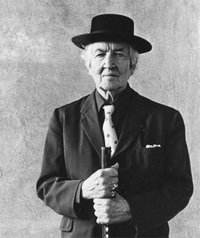About the Author: Robert Graves

Robert Ranke Graves, born in Wimbledon, received his early education at King's College School and Copthorne Prep School, Wimbledon & Charterhouse School and won a scholarship to St John's College, Oxford. While at Charterhouse in 1912, he fell in love with G. H. Johnstone, a boy of fourteen ("Dick" in Goodbye to All That) When challenged by the headmaster he defended himself by citing Plato, Greek poets, Michelangelo & Shakespeare, "who had felt as I did".
At the outbreak of WWI, Graves enlisted almost immediately, taking a commission in the Royal Welch Fusiliers. He published his first volume of poems, Over the Brazier, in 1916. He developed an early reputation as a war poet and was one of the first to write realistic poems about his experience of front line conflict. In later years he omitted war poems from his collections, on the grounds that they were too obviously "part of the war poetry boom". At the Battle of the Somme he was so badly wounded by a shell-fragment through the lung that he was expected to die, and indeed was officially reported as 'died of wounds'. He gradually recovered. Apart from a brief spell back in France, he spent the rest of the war in England.
One of Graves's closest friends at this time was the poet Siegfried Sassoon, who was also an officer in the RWF. In 1917 Sassoon tried to rebel against the war by making a public anti-war statement. Graves, who feared Sassoon could face a court martial, intervened with the military authorities and persuaded them that he was suffering from shell shock, and to treat him accordingly. Graves also suffered from shell shock, or neurasthenia as it is sometimes called, although he was never hospitalised for it.
Biographers document the story well. It is fictionalised in Pat Barker's novel Regeneration. The intensity of their early relationship is nowhere demonstrated more clearly than in Graves's collection Fairies & Fusiliers (1917), which contains a plethora of poems celebrating their friendship. Through Sassoon, he also became friends with Wilfred Owen, whose talent he recognised. Owen attended Graves's wedding to Nancy Nicholson in 1918, presenting him with, as Graves recalled, "a set of 12 Apostle spoons".
Following his marriage and the end of the war, Graves belatedly took up his place at St John's College, Oxford. He later attempted to make a living by running a small shop, but the business failed. In 1926 he took up a post at Cairo University, accompanied by his wife, their children and the poet Laura Riding. He returned to London briefly, where he split with his wife under highly emotional circumstances before leaving to live with Riding in Deià , Majorca. There they continued to publish letterpress books under the rubric of the Seizin Press, founded and edited the literary journal Epilogue, and wrote two successful academic books together: A Survey of Modernist Poetry (1927) and A Pamphlet Against Anthologies (1928).
In 1927, he published Lawrence and the Arabs, a commercially successful biography of T.E. Lawrence. Good-bye to All That (1929, revised and republished in 1957) proved a success but cost him many of his friends, notably Sassoon. In 1934 he published his most commercially successful work, I, Claudius. Using classical sources he constructed a complexly compelling tale of the life of the Roman emperor Claudius, a tale extended in Claudius the God (1935). Another historical novel by Graves, Count Belisarius (1938), recounts the career of the Byzantine general Belisarius.
During the early 1970s Graves began to suffer from increasingly severe memory loss, and by his eightieth birthday in 1975 he had come to the end of his working life. By 1975 he had published more than 140 works. He survived for ten more years in an increasingly dependent condition until he died from heart failure.



